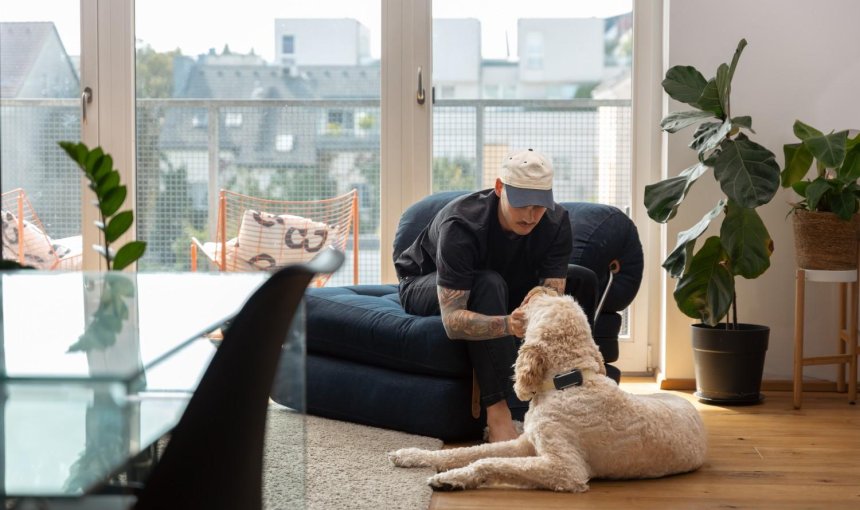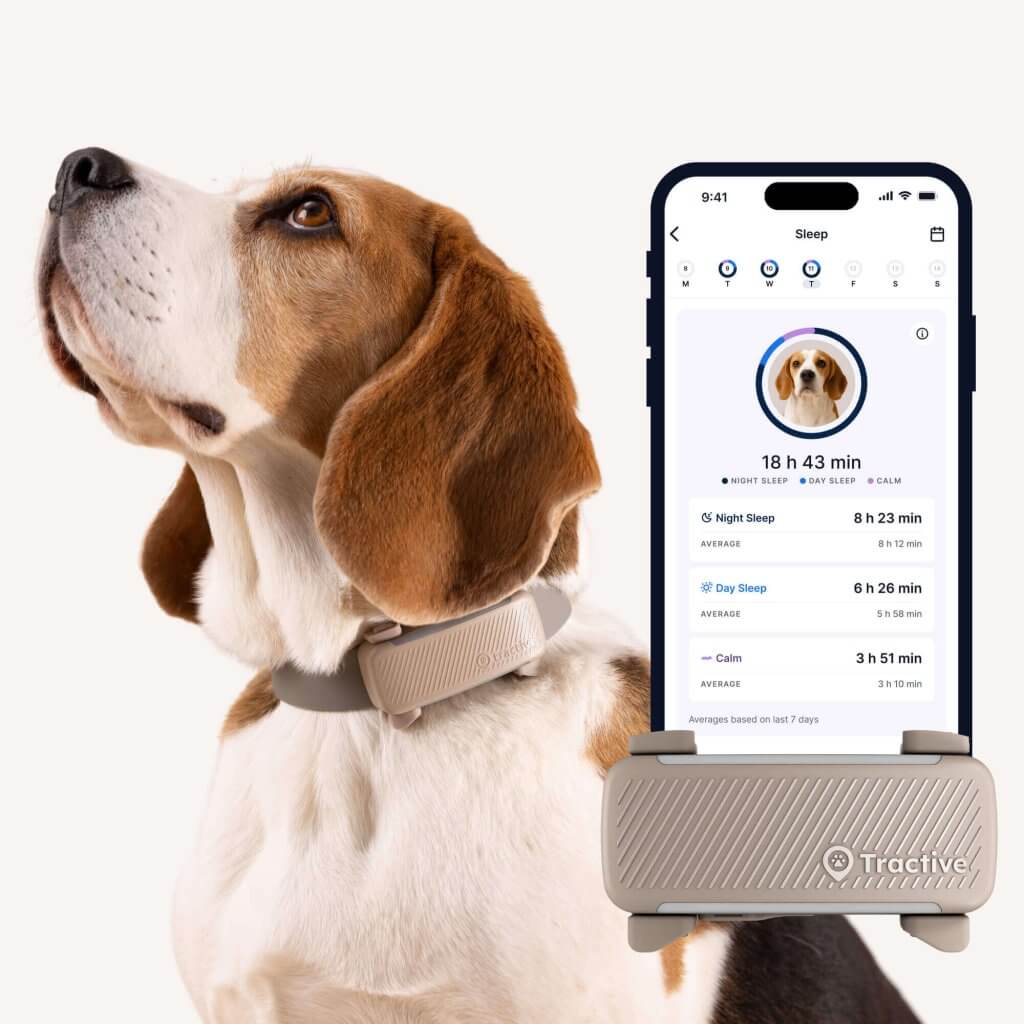13 Fun Games For Dogs (For When You’re Cooped Up Indoors)
Stuck indoors on a rainy day? Here are a whole bunch of fun indoor games for dogs to keep you both on your toes all day long!

Much like us, dogs need their exercise – both physical and mental. Here are a couple of games for dogs that are perfect for a rainy day when you’re both cooped up indoors. (And the best way to keep your dog safe, if they end up lost or stuck somewhere inside your house while playing hide and seek – or end up jumping the fence out of boredom!)

Always know your buddy is healthy & safe
Read more9 fun brain games for dogs for a rainy day
With a bit of creativity, you can turn your home into a fun and enriching space for your buddy. So here are a couple of brain games for dogs to keep both their mind and body active – while also keeping them safe indoors.
1. Hide some treats around the house
And get your buddy to sniff them out, one by one. Put your dog in a “sit” or “stay” position – and hide a treat or favorite toy somewhere easy at first. Then give your dog a cue to go find the toy. (Something like a clear instruction like, “Find it!”)
Once your dog understands the game, you can make it more difficult by hiding the treat or toy in another room, or in baskets and boxes. Reward your dog with a ton of pets and praise when they find the treat!
2. Invest in interactive toys & puzzle feeders
Interactive (food-dispensing) toys and puzzles are invaluable boredom busters. They’re key to challenging your dog’s brain and keeping them occupied – especially if you’re not at home with them. (Also keeping their inner foraging instincts happy.) In a nutshell, toys like this require your dog to figure out how to get the treats inside. For example:
- Start by filling a food dispensing toy with some treats your dog loves.
- Usually, the toy sits upright until your dog pushes it with their paw or nose.
- Once they do, the toy periodically disposes a treat as it spins and rolls.
These kinds of food puzzles come with a bunch of difficulty levels, so you can adjust the challenge according to your dog’s skill level. They can both help keep your dog busy – and help slow down fast eaters.
3. Play the Muffin Tin game
This easy game helps your dog problem-solve, use their senses, and get resourceful. With an empty muffin tin, some tennis balls, and few treats, you’re good to go!
- Place some treats in the muffin tin cups. (Make sure your dog sees you doing this.)
- Cover the cups with tennis balls, or any object that’s easy for your dog to bat or move away. (But which covers the treats.)
- Let your dog sniff around and figure out how to remove the balls and get to the treats!
4. Teach your dog the names of items
The average dog can learn up to a whopping 165 words!2 (Meaning, yes, they most likely do understand that “slippers”, “Christmas tree”, and “chocolate” are off-limits.) So if you teach your buddy the names of different objects around the house, you can keep their minds active – and also help teach them what’s a no-no and what’s safe instead.
Start with a few, specific, familiar objects (like a ball, their food bowl, and leash.) Repeat the names of these objects while pointing to them. If your dog paws at one of the objects, repeat its name and give them a treat.
Now call out “Ball” or “Leash” repeatedly – and give your dog a treat if they pick the correct object. Repeat this periodically and practice until your dog can fetch these items when you call out their name. With time, you can move to other, more complex items – especially ones that are off-limits. Make sure to emphasize “No” firmly so your dog gradually learns to avoid them.
5. Revisit your dog’s training
A well-trained dog is a happy one – and also less likely to run away from home out of boredom or make a nuisance of themselves outdoors. Regular training also helps refresh the connections they’ve built in their brains and keep them mentally active. So it’s one of the best brain games for dogs, hands down. Make sure to revisit your dog’s training on basic commands like:
- Sit
- Stay
- Drop it
- Come
Read more: 4 Important Dog Commands & How To Teach ‘Em
6. Teach your dog new tricks & commands
Besides refreshing older commands, it’s always fun to keep things challenging and teach your dog some new tricks and commands as well! This helps keep your dog’s brain sharp well into their grand-paw years. So if you haven’t already, you can spice up your dog’s regular training sessions with a new trick or command every so often. Starting with simple ones like:
- Play dead
- Fetch
- High five
- Roll over
And if you want to shake things up a bit, try a fun, practical training method like clicker training. It’s built on positive reinforcement, so it’ll both help your dog’s training stay fresh – and strengthen your bond that much better.
7. The Cups game
This classic game is a great way to engage your dog’s problem-solving skills, curiosity, and ability to focus and concentrate. And the best part? All you need are three cups and a treat!
- Show your dog the treat and let them sniff it, getting familiar with it.
- Place the treat under one of the cups. (Make sure your dog sees which one.)
- Next, shuffle the cups around. Go slow at first, allowing your dog to follow the motion.
- Let your dog sniff and nudge the cups around to find the hidden treat.
Your dog’s senses and memory all get engaged by the challenge of locating the treat under the correct cup. Just make sure to increase the difficulty gradually so that they don’t get frustrated – and reward them plenty when they find the treat!
8. Giving your dog a “job”
If you train them to complete a specific task (or tasks) throughout the day, you can prevent them from chewing up your slippers into a pulp to stay occupied. Like, for example:
- Putting back their toys into their boxes or buckets
- Fetching specific items for you (like an object from another room)
- Closing and opening doors, drawers, or kitchen cabinets
- Preventing your kids from venturing outside (if you’ve instructed them to stay indoors)
- Getting rid of any junk mail or delivery boxes (including chewing or shredding it up, if it’s paper or cardboard)
- Waking up your kids in the morning before school
- Handing back dropped items
- Herding your kids back in place if they wander off while you’re all outdoors
9. Hide & seek
Hide and seek isn’t just for your kids – dogs love it too! Much like sniffing out treats, you can help keep your dog’s brain active and get them to use both their sense of hearing and smell to “track” you down. So start by:
- Getting your dog to stay in one place – or get someone else to hold them. (See why teaching them “Stay” is such an important command?)
- Hide somewhere relatively easy in your house. (Like an easily accessible room.)
- Call out your dog’s name to find you.
- Give your dog a ton of pets and praise once they do find you!
This way, you can both tap into your dog’s natural hunting instincts and give them an excellent mental exercise – plus, help improve their recall, all in one.
💡An Activity Tracker for dogs can help you figure out how many calories your dog has burned from all this exercise – and also how active your dog is compared to other, similar dogs around the world.

Help your dog stay fit and healthy
Get a complete overview of how much exercise and rest they’re getting. Compare their activity to that of similar dogs. Set daily goals. And find out if something might be off with Health Alerts.
4 easy indoor games for dogs
Now we’ve covered brain games for dogs – but how about regular physical games? Here are a couple you can do easily at home and with zero stress.
1. Tug of War
A good game of tug-of-war can help your buddy burn off some excess energy indoors – while also getting their chewing fix. All you need is some kind of sturdy rope, frisbee, or a chew toy long enough to hold on both sides.
- Just make sure to pick an object that isn’t harmful if your dog chews on it.
- Make sure to reinforce commands like “Stop” in case things get a bit too excited.
- We’d also recommend you let your dog win occasionally to keep it fun!
2. Going up & down the stairs
Got stairs in your house, your fire exit, or even just outside your apartment? Going up and down can help both you and your buddy stay in shape, as well as helping your dog get some activity throughout the day. Besides, if you’ve got a puppy, it helps build their mobility and independence as they grow. If you’re both well-coordinated enough, you can even play a game of fetch on the stairs! Just throw a ball up or down to encourage your dog to run up or down to retrieve it.
3. A DIY obstacle course
You can easily create an obstacle or agility course with some household objects – and help your dog get the exercise and mental stimulation they need as they navigate through them. Just make sure to set it up in a slightly bigger room in your home – maybe your living room. Where you can use:
- Towels or blankets to create tunnels for them to run through
- Chairs for your dog to weave around
- Broomsticks as jumps
Also, make sure to guide your dog through the course first, so they get familiar with it – and improve their coordination and agility with time. Reward them plenty for completing each section and you’ll both be engaged for hours on end!
4. Keep away
Use one of your dog’s favorite balls or toys to get their attention first (without giving it to them.) Pass it between you and your partner without dropping it. Let your dog do their best to try and grab it!
This game works great for families with two or more dogs, who can play it even without any humans around. (Just make sure to use an object that’s safe for chewing and grabbing.) Plus, even if you don’t have any company, you can play against yourself by throwing the ball against a wall or some other flat surface – and letting your dog try and intercept it.
Another variant of this game is like a doggy “Hot Potato” – where you can’t let the object fall on the ground! You can do this easily with a safe item like a balloon, keeping it afloat with your dog as much as possible.
Ready to make the most of your next rainy day indoors?
With these activities, you’ll be keeping your buddy fit, happy, healthy, and more likely to age well in the long run – and live a longer life by your side.



